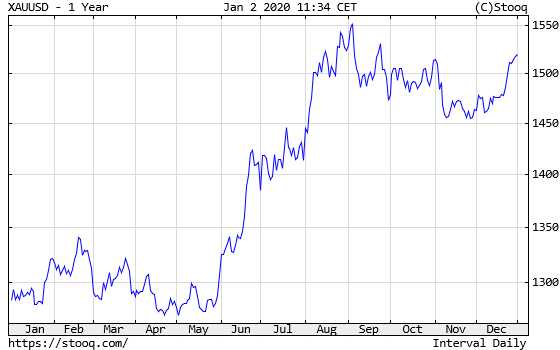Hooray, the twenties are here! But what will the 2020 bring for the gold market? Shall we see the beginning of the Belle Époque for the yellow metal?
Gold at the End of 2019
The last year was a very good one for gold bulls, as one can clearly see in the chart below. Despite the soaring equities, the price of the yellow metal rose from $1279 to around $1520, or more than 18 percent. Bravo!
Chart 1: Gold prices in 2019.

In particular, gold managed to jump again above $1,500 at the very end of December, which confirms that the turn of the year is usually positive for gold prices. In the last few years, gold rallied in the beginning of year. So, looking at gold’s seasonality, January could be positive for the price of the yellow metal. But what about the rest of the year? Below I offer a few key insight. The more detailed fundamental outlook for gold in 2020, I provide in January edition of the Gold Market Overview.
Fundamental Outlook for Gold in 2020
From the fundamental point of view, 2020 may be worse for the yellow metal than in 2019. This is because the dovish central bank pivot that drove precious market in 2019 is largely behind us. The impact of existing accommodative U.S. fiscal policy is fading. The fears of recession are receding. The risks of the full blown U.S.-China trade war and a hard Brexit have diminished.
In other words, the monetary policy will be more hawkish than in 2019, while the fiscal policy will be similarly easy, supporting the U.S. dollar. The geopolitical headwinds have softened, which should help the risky assets and bond yields. So, we could see strong dollar, higher real interest rates and lower risk aversion – a very bad combination for the price of gold.
On the other hand, the next Fed move will be an interest rate cut, which can happen as early as this year. The expectation of a dovish move could support gold prices. Moreover, the U.S. GDP growth is expected to slow down, while inflation may finally rise. Meanwhile, growth may accelerate in other countries – if that happens, the greenback may weaken. Flatter U.S. growth with higher inflation and weakening dollar seems to be a positive combination for the gold prices.
However, the dovish expectations are already priced in to some extent, while inflation will not soar, but edge up, if at all. Given the dovish stance of the ECB and Bank of Japan, the U.S. dollar may remain relatively strong. This is why our base case is that fundamental outlook has deteriorated somewhat and after possibly pleasant beginning of the year, gold may struggle further down the road.
But black swans are flying just above the market surface. So, investors should be aware that they could be hit at some point with the harsh reality of economic slowdown in China and other countries, debt saturation, declining corporate profits, and uncertainty about the outcomes of the U.S. elections. In such an environment, gold will continue to be seen as an important safe-haven asset.
Disclaimer: Please note that the aim of the above analysis is to discuss the likely long-term impact of the featured phenomenon on the price of gold and this analysis does not indicate (nor does it aim to do so) whether gold is likely to move higher or lower in the short- or medium term. In order to determine the latter, many additional factors need to be considered (i.e. sentiment, chart patterns, cycles, indicators, ratios, self-similar patterns and more) and we are taking them into account (and discussing the short- and medium-term outlook) in our trading alerts.
